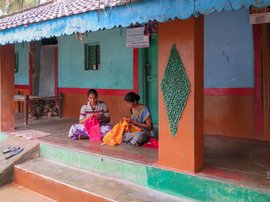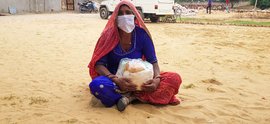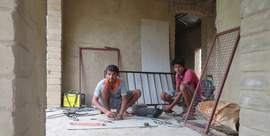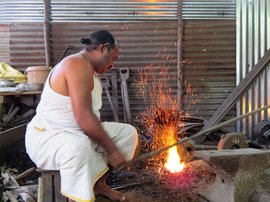A dargah located on a barren plateau has served Malgaon’s residents well. This shrine in Maharashtra’s Satara district has been around for centuries and has always been a refuge.
School children do their homework under the tree that leans against the dargah . Young men and women prepare for the competitive civil service examinations at the entrance – the only place where cool breeze flows during the scorching summers; aspiring policemen put themselves through rigorous fitness training sessions in the open space around.
“Even my grandfather has stories of it [the dargah ],” says Vinayak Jadhav, 76, a farmer with over 15 acres in the village. “Imagine how old it must be. Hindus and Muslims have maintained it together. It has been a symbol of peaceful coexistence.”
Things changed in September 2023. The much-loved shrine acquired a new meaning in Malgaon – a small but loud group of young men claimed it was an encroachment. They had been egged on by a coalition of Hindutva groups.
These Hindu residents of Malgaon aged between
20-25 wrote to the district administration, demanding to take down the “illegal
encroachment”. Some of them had already destroyed the water tank next to it.
“The Muslim community wants to usurp the public land around it,” their letter
read. “The shrine is built against the wishes of the
gram panchayat
.”

Vinayak Jadhav (wearing a Gandhi topi) with friends at the shrine in Malgaon. This shrine in Maharashtra’s Satara district has been around for centuries
However, when the calls to bulldoze the shrine came in, the village stepped up for what was right. “The shrine finds a mention even in the maps of 1918,” Jadhav says, meticulously unfolding a faded paper. “There are so many religious places in the village that have existed before Independence. We want to preserve them all. We want our children to grow up in a peaceful atmosphere.
He adds: “ Dharma-Dharma madhe bhandan laun aapan pudhe nahi, maage janar [Dividing people on religious lines will only take us back].”
After the Hindutva members call to tear down the dargah , senior members of both communities came together in Malgaon and issued a letter against it. The letter categorically stated that this demand doesn’t represent the views of the majority. Two hundred Muslims and Hindus across caste lines signed it. They managed to save the shrine – for now.
The bigger challenge is to preserve this hard-earned
peace.
*****
Malgaon is a rare example where the village stood up to divisive elements and protected a monument belonging to the Muslim community.
Over the past year and a half, Muslim places of worship in Maharashtra have increasingly come under attack, and more often than not, the perpetrators have gotten away with it – largely because of police inaction and the silence of the majority.
For two and a half years after the state elections of 2019, India’s richest state was ruled by an alliance of three political parties – Shiv Sena, Congress and Nationalist Congress Party, with Uddhav Thackeray as the Chief Minister.
However, in June 2022, Maharashtra
saw a change of power after the Bharatiya Janata Party (BJP) poached 40 of Shiv
Sena’s legislators and formed a government by overthrowing the alliance. Ever
since then, radical Hindu groups have come together and addressed dozens of
rallies across the state, calling for the extermination of Muslims as well as
their economic boycott. It’s a concerted
attempt to vitiate the atmosphere in the state and the attacks on religious
places of Muslims is a part of it.


Left: School children do their homework under the tree that leans against the dargah . Young men and women prepare for the competitive civil service examinations at the entrance. Right: Jadhav riding his scooty up to the dargah . ' There are so many religious places in the village that have existed before Independence. We want to preserve them all,' he says
Minaj Sayyad, a social activist based in Satara, says this plan to polarise has been in the works for years, but its intensity has increased since 2022. “Monuments like dargahs or tombstones, which are protected and maintained by both Hindus and Muslims in the village, are under attack,” he says. “The agenda is to target syncretic culture.”
In February 2023, a group of radical Hindus launched a rocket on a dargah of Hazrat peer Malik Rehan Shah in Kolhapur’s Vishalgad town. The incident took place in the presence of the police.
In September 2023, members of Hindu Ekta, a radical group headed by BJP’s Vikram Pavaskar, launched a murderous attack on a mosque in the village of Pusesavali in Satara in retaliation for unproven screenshots that had gone viral on WhatsApp. About 10-12 Muslims praying peacefully inside it were assaulted with tiles, sticks and iron rods, with one of them succumbing to his injuries. Read: In Pusesavali: doctored images , destroyed lives
In December 2023, Salokha Sampark Gat, – a group that works towards establishing communal harmony – published a booklet that documented 13 such attacks on Muslims’ places of worship in only one district of Satara. The nature of the attacks ranged from destroying a tomb to hoisting a saffron flag on top of a mosque, ensuring further escalation of communal disharmony.
In just one year of 2022,
Maharashtra recorded more than 8,218 incidents of rioting, in which over 9,500
citizens were affected, according to the booklet. That’s a staggering average
of 23 rioting incidents every day for a year.


Left : A booklet published by Salokha Sampark Gat has documented 13 attacks on Muslims’ places of worship in only one district of Satara. In just one year of 2022, Maharashtra recorded more than 8,218 incidents of rioting, in which over 9,500 citizens were affected, according to the booklet. Right: The shrine at Malgaon, maintained by Hindus and Muslims stands as a symbol of communal harmony
When Shamsuddin Sayyad, 53, walked up to the mosque in his village of Kondwe in Satara district one morning in June 2023, his heart skipped a beat. A saffron flag with ‘ Jai Shree Ram (Hail Lord Ram)’ written in black, fluttered boldly on the curvy minaret, sending Sayyad into a panic. He immediately called the police and asked them to take control of the situation. But even as the police stood in the narrow lane observing the flag being taken down, he feared an impending law and order crisis.
“A Muslim boy had uploaded a status of Tipu Sultan a couple of days before,” explained Sayyad, who is a trustee of the mosque. “The Hindutva groups didn’t like the glorification of the 18th century Muslim ruler so they wanted to avenge it by desecrating the village mosque.”
Sohail Pathan, 20, the young man behind the Tipu Sultan status, immediately regretted uploading it: "I shouldn't have done it," he says. "I put my family in danger with an Instagram story."
Hours after his post went up, a group of radical Hindus landed up at his dimly lit, one-room hut and slapped him across the face. “We didn’t retaliate because it would’ve only escalated the situation,” Sohail says. “But it was just an Instagram story. They just need a reason to attack Muslims.”
The same night he was slapped, the police intervened and filed a case – on Sohail. He had to spend the night in a police station, and his case is going on in the district court where he is accused of spreading religious enmity. The people who slapped him roam free.
Sohail’s mother, Shahnaz,
46, says their family has been living in Satara for generations but never faced
this kind of hostility or surveillance of their social media activities. “My
parents and grandparents decided to stay in India during Partition because we
believed in a secular constitution,” she says. “This is my land, this is my
village, this is my home. But I feel scared for my children when they go out
for work.”

Sohail Pathan, a resident of Kondwe village in Satara, had uploaded a status about Tipu Sultan on his social media account after which the mosque in his village was vandalised and he was attacked at home
Sohail works at a garage, and his brother Aftab, 24, is a welder. They are the only two earning members of the family, making about Rs. 15,000 per month. The frivolous case against Sohail has cost them two month’s income in posting bail and lawyer’s fees. “You can see how we live,” Shahnaz says, pointing towards her small house where Aftab’s welding machine is crammed against walls on which the paint is peeling. “We can’t afford to spend money on a court case. The only good thing is that the village peace committee stepped in and calmed things down.”
Madhukar Nimbalkar, 71, a farmer and a senior member of the peace committee in Kondwe says this was the first time the committee has had to intervene ever since its inception in 2014. “We held a meeting at the mosque where the saffron flag was hoisted,” he says. “Both the communities resolved not to escalate the situation.”
The meeting, Nimbalkar
says, was held at the mosque for a reason. “The open space in front of it has
long been used for Hindu weddings,” he explains. “The idea was to remind people
how we have lived for all these years.”
*****
On January 22, 2024, the Ram Lalla temple was inaugurated in Ayodhya. The Supreme Court unanimous order issued in November 2019 handed over the disputed land in Ayodhya for the construction of the temple. It has been built on the site of the Babri Masjid mosque that was torn down four decades ago by radical Hindu groups led by the Vishwa Hindu Parishad.
Ever since, the destruction of the Babri Masjid has become a rallying cry for polarisation in India.
While the Supreme Court
justices found the demolition of Babri Mosque to be unconstitutional, its order
granting the land for the building of the temple, has ended up rewarding and
emboldening the perpetrators. Observers believe the decision has further given
strength to radical groups to go after Muslims’ places of worship in remote
villages beyond the media spotlight.


Naseem holds up a photo of his son who was attacked and injured by a mob in 2023 . Vardhangad, where Naseem lives with his family, has a rich history of religious pluralism
Minaj Sayyad says the status quo regarding religious places was accepted across communities at the time of Independence in 1947. “The Supreme Court verdict reversed that,” he says. “Because it didn’t stop at Babri. The Hindu groups are now coming after other mosques.”
As his village, district and state head into hostile times, Hussain Shikalgar, 69, a tailor in Satara’s Vardhangad village, sees a clear generational divide. “The younger generation has been totally brainwashed,” he says. “People my age miss the old days. I have seen the polarisation after the Babri Mosque was demolished. It was nowhere close to the tensions we have today. I was elected the sarpanch of this village in 1992. Today, I feel like a second-class citizen.”
Shikalgar’s commentary is particularly damning as his village is known to have embraced religious pluralism for years. Located in the foothills of Fort Vardhangad, the village is a pilgrimage spot for devotees from all over Maharashtra. A hilly forested terrain in the village is a site of five tombstones and temples in relatively close proximity to each other, where Hindus and Muslims pray side by side. Both the communities have maintained the site together, or they did until July 2023.
Vardhangad has been home to
four monuments ever since “unknown residents” vandalised the tombstone in June
2023 belonging to Peer Da-Ul Malik, where Muslims regularly offered their
prayers. The next month, the forest department then flattened the tombstone
entirely, terming it an illegal construction. The Muslims wonder why it was the
only structure to be demolished among the five.

The tombstone in Vardhangad before it was destroyed. Muslim residents of the village ask why their monuments are being singled out for encroachment
“It was an attempt to provoke Muslims in the village,” says Mohammad Saad, 21, a student and resident of Vardhangad. “I was targeted over a social media post during the same time.”
Saad’s cousin brother – who lives a couple of hours away in Pune – had uploaded an Instagram post of the 17th century ruler, Aurangzeb. Offended by the post, members of the Hindutva groups landed up at Saad’s doorstep the same night and dragged him out of the house, and started beating him up with iron rods and hockey sticks, calling him “ Aurangzeb ki aulad [Son of Aurangzeb].”
“It was late in the night, and I could have easily died,” Saad recalls. “Luckily a police vehicle was passing by at the same time. The mob saw the vehicle and ran away.”
Saad spent the next 15 days in the hospital with head injuries, a broken leg and a fractured cheekbone; he vomited blood over the next few days. Even today, he finds it tough to travel by himself. “I feel I could be targeted again,” he confesses. “I can’t focus on my studies.”
Saad is studying for a degree in Bachelor of Computer Science. He is a bright, sincere student who scored 93 per cent marks in his Class 12 board exams. But his numbers have taken a hit in recent months. “Three days after I was hospitalised, my uncle had a heart attack and died,” he says. “He was 75, but he was healthy. He didn’t have heart issues. It was clearly a stress-induced attack. I can’t forget about him.”
Ever since the incident,
Muslims have begun to keep to themselves, not mingling with Hindus anymore. It
has changed the face of the village. Old friendships strained; relationships
lost.


Left: ‘It was an attempt to provoke Muslims in the village,' says Mohammad Saad, a student and resident of Vardhangad. Right: Hussain Shikalgar, a tailor from Vardhangad says, ‘I have stitched clothes for the entire village all my life. Over the past couple of years, my Hindu customers have dropped out. I am not sure if it is out of spite or peer pressure’
Shikalgar says it isn’t about just these two instances. The alienation is evident in day to day things.
“I am a tailor,” he says. “I have stitched clothes for the entire village all my life. Over the past couple of years, my Hindu customers have dropped out. I am not sure if it is out of spite or peer pressure.”
Even the language has changed, he adds. “I don’t remember hearing the word ‘ landya ’ for the longest time,” he says, referring to a slur used for Muslims. “These days, we hear it a lot. Hindus and Muslims have stopped seeing eye to eye.”
Vardhangad is not an anomaly is western Maharashtra, the region in which Satara falls. Communal tensions have segregated villages along religious lines, changing the face of festivals and marriage ceremonies in rural areas.
Shikalgar says he used to be at the forefront in organising the Hindu Ganesh festival in Vardhangad, while many Hindus participated in Urs, an annual festival commemorating the death anniversary of Sufi saint Mohinuddin Chishti. Even a wedding in the village used to be a common affair. “All of that is lost now,” he laments. “There was a time when music stopped during Ram Navami while passing by a mosque out of respect. Now, it gets louder to disturb us.”
Yet a significant section from both the communities believe that all is still not lost, and the mobs driving a wedge between religions don’t represent the interests of the majority. “They are loud, they have state support, so it seems like they are a lot of them,” says Jadhav from Malgaon. “Most of the people want to lead their lives without controversy so the Hindus are afraid to speak up. That needs to change.”
Jadhav believes what Malgaon did could be a blueprint for the rest of Satara, if not the whole state of Maharashtra. “The moment Hindus stepped in to save the dargah , the radical elements went on the backfoot,” he stresses. “The onus of saving religious pluralism is on us, not on Muslims. Our silence emboldens the anti-social elements.”




